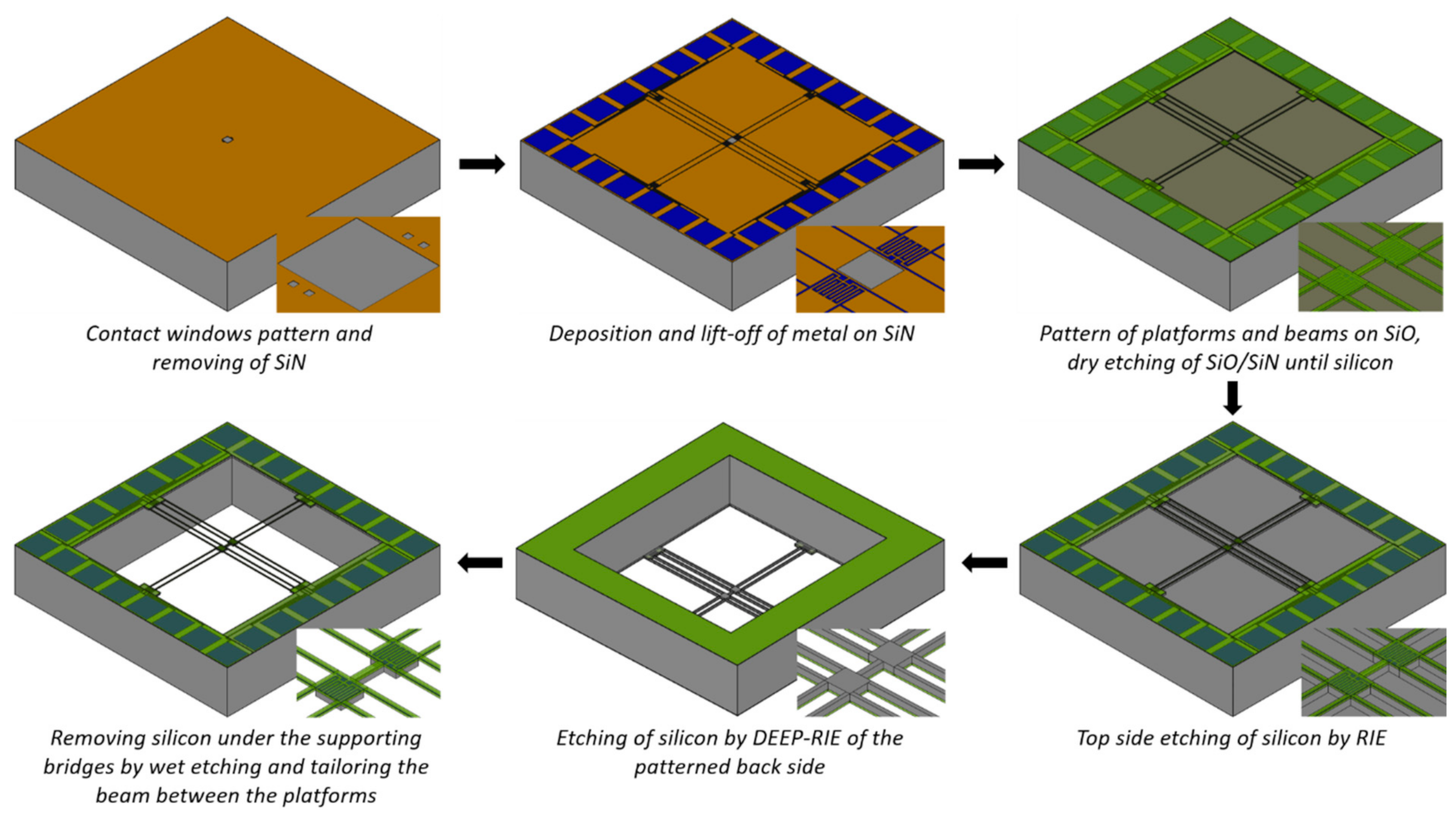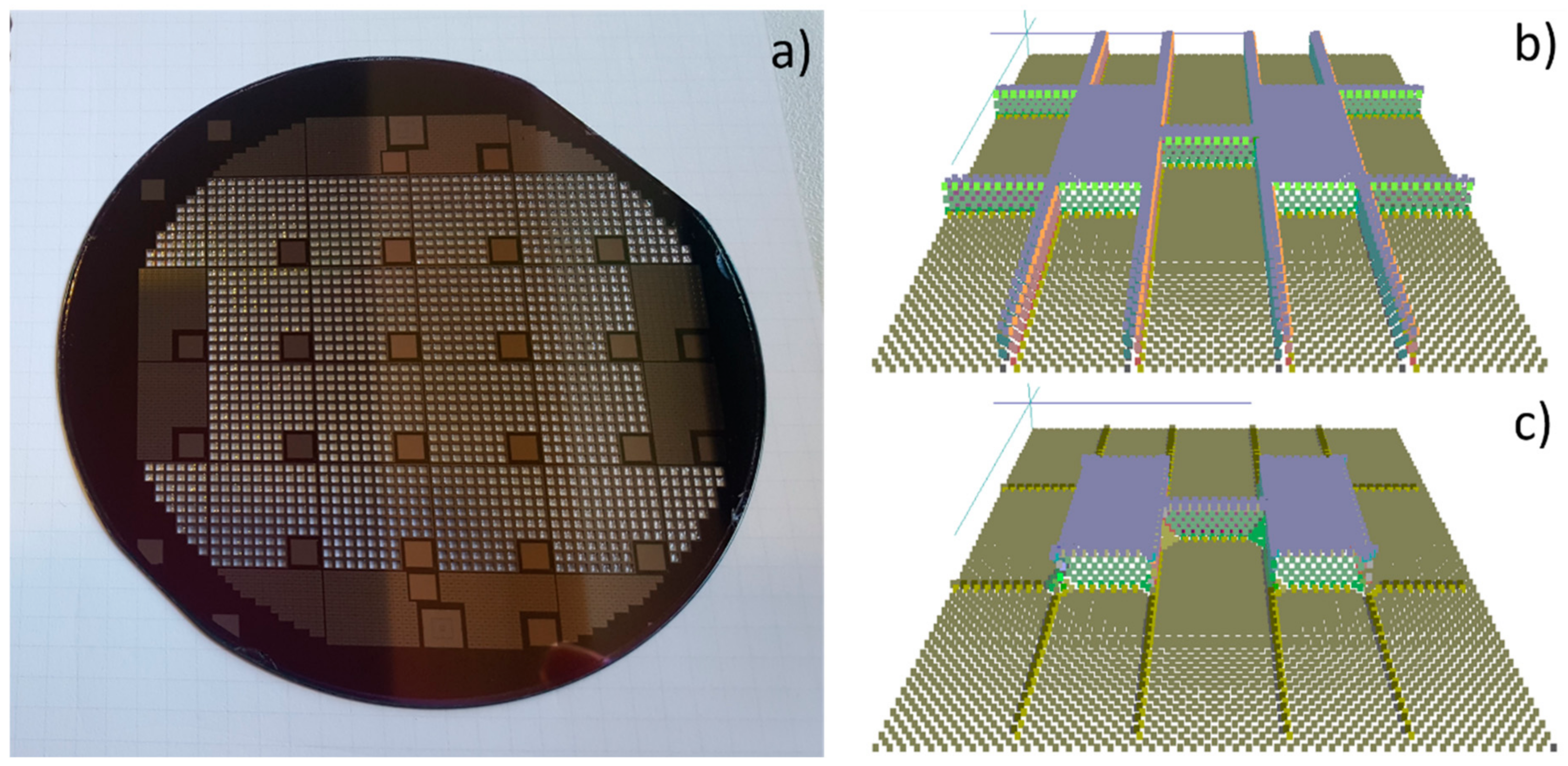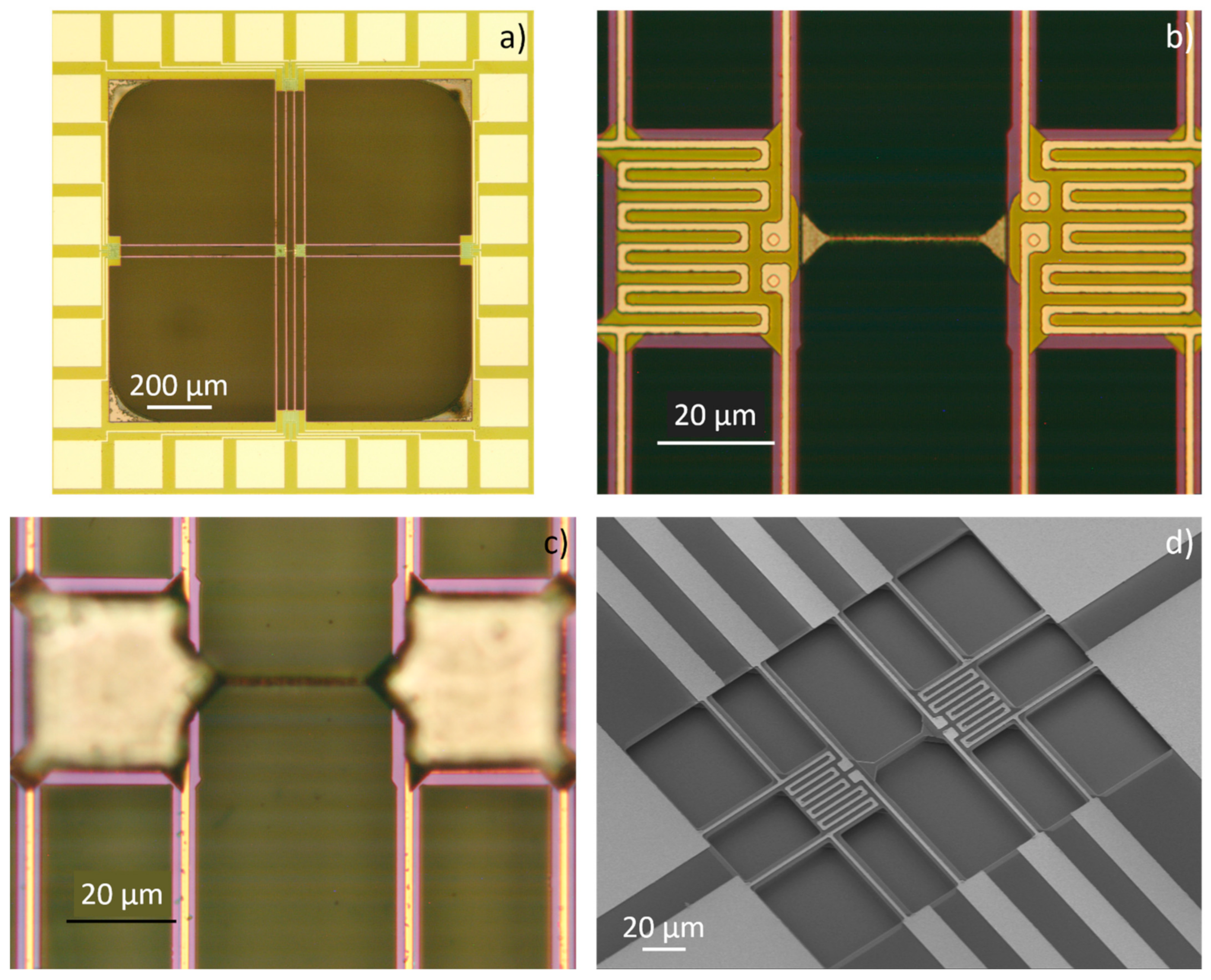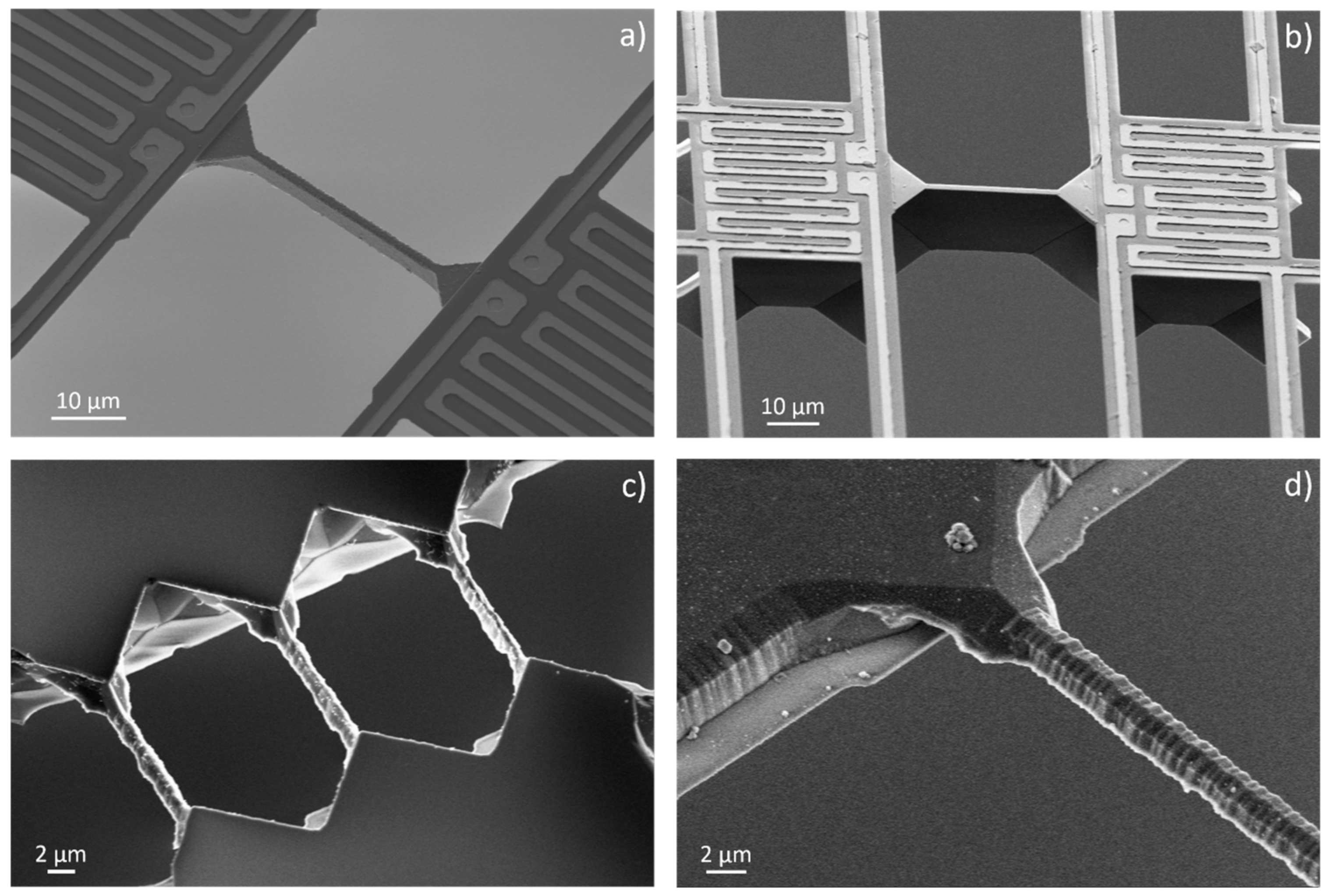New Fabrication Method of Silicon Sub-Micron Beams with Monolithic Contacts for Thermoelectric Transport Properties Analysis
Abstract
:1. Introduction
2. Materials and Methods
2.1. Materials
2.2. Device Fabrication
3. Results and Discussion
4. Conclusions
Author Contributions
Funding
Institutional Review Board Statement
Informed Consent Statement
Data Availability Statement
Conflicts of Interest
References
- Narducci, D. Thermoelectric harvesters and the internet of things: Technological and economic drivers. J. Phys. Energy 2019, 1, 024001. [Google Scholar] [CrossRef]
- Park, H.; Lee, D.; Park, G.; Park, S.; Khan, S.; Kim, J.; Kim, W. Energy harvesting using thermoelectricity for IoT (Internet of Things) and E-skin sensors. J. Phys. Energy 2019, 1, 042001. [Google Scholar] [CrossRef]
- Nestorova, G.G.; Kopparthy, V.L.; Crews, N.D.; Guilbeau, E.J. Thermoelectric lab-on-a-chip ELISA. Anal. Methods 2015, 7, 2055–2063. [Google Scholar] [CrossRef]
- Gadea, G.; Pacios, M.; Morata, Á.; Tarancón, A. Silicon-based nanostructures for integrated thermoelectric generators. J. Phys. D Appl. Phys. 2018, 51, 423001. [Google Scholar] [CrossRef]
- Donmez Noyan, I.; Dolcet, M.; Salleras, M.; Stranz, A.; Calaza, C.; Gadea, G.; Pacios, M.; Morata, A.; Tarancon, A.; Fonseca, L. All-silicon thermoelectric micro/nanogenerator including a heat exchanger for harvesting applications. J. Power Sources 2019, 413, 125–133. [Google Scholar] [CrossRef]
- Pennelli, G.; Macucci, M. High-power thermoelectric generators based on nanostructured silicon. Semicond. Sci. Technol. 2016, 31, 054001. [Google Scholar] [CrossRef]
- Choi, J.; Cho, K.; Kim, S. Flexible Thermoelectric Generators Composed of n-and p-Type Silicon Nanowires Fabricated by Top-Down Method. Adv. Energy Mater. 2017, 7, 1602138. [Google Scholar] [CrossRef]
- Glynn, C.; Jones, K.-M.; Mogili, V.; McSweeney, W.; O’Dwyer, C. The Nature of Silicon Nanowire Roughness and Thermal Conductivity Suppression by Phonon Scattering Mechanisms. ECS J. Solid State Sci. Technol. 2017, 6, N3029–N3035. [Google Scholar] [CrossRef] [Green Version]
- Hao, Q.; Xu, D.; Zhao, H.; Xiao, Y.; Medina, F.J. Thermal Studies of Nanoporous Si Films with Pitches on the Order of 100 nm —Comparison between Different Pore-Drilling Techniques. Sci. Rep. 2018, 8, 9056. [Google Scholar] [CrossRef] [PubMed] [Green Version]
- Nomura, M.; Shiomi, J.; Shiga, T.; Anufriev, R. Thermal phonon engineering by tailored nanostructures. Jpn. J. Appl. Phys. 2018, 57, 080101. [Google Scholar] [CrossRef]
- Park, W.; Romano, G.; Ahn, E.C.; Kodama, T.; Park, J.; Barako, M.T.; Sohn, J.; Kim, S.J.; Cho, J.; Marconnet, A.M.; et al. Phonon Conduction in Silicon Nanobeam Labyrinths. Sci. Rep. 2017, 7, 6233. [Google Scholar] [CrossRef] [PubMed]
- Swinkels, M.Y.; Zardo, I. Nanowires for heat conversion. J. Phys. D Appl. Phys. 2018, 51, 353001. [Google Scholar] [CrossRef]
- Weber, L.; Gmelin, E. Transport properties of silicon. Appl. Phys. A 1991, 53, 136–140. [Google Scholar] [CrossRef]
- Slack, G.A. Thermal Conductivity of Pure and Impure Silicon, Silicon Carbide, and Diamond. J. Appl. Phys. 1964, 35, 3460–3466. [Google Scholar] [CrossRef]
- Glassbrenner, C.J.; Slack, G.A. Thermal Conductivity of Silicon and Germanium from 3 °K to the Melting Point. Phys. Rev. 1964, 134, A1058–A1069. [Google Scholar] [CrossRef]
- Geballe, T.H.; Hull, G.W. Seebeck Effect in Silicon. Phys. Rev. 1955, 98, 940–947. [Google Scholar] [CrossRef]
- Ohishi, Y.; Xie, J.; Miyazaki, Y.; Aikebaier, Y.; Muta, H.; Kurosaki, K.; Yamanaka, S.; Uchida, N.; Tada, T. Thermoelectric properties of heavily boron- and phosphorus-doped silicon. Jpn. J. Appl. Phys. 2015, 54, 071301. [Google Scholar] [CrossRef]
- Stranz, A.; Kähler, J.; Waag, A.; Peiner, E. Thermoelectric Properties of High-Doped Silicon from Room Temperature to 900 K. J. Electron. Mater. 2013, 42, 2381–2387. [Google Scholar] [CrossRef]
- Ju, Y.S. Phonon heat transport in silicon nanostructures. Appl. Phys. Lett. 2005, 87, 153106. [Google Scholar] [CrossRef]
- Schierning, G. Silicon nanostructures for thermoelectric devices: A review of the current state of the art. Phys. Status Solid 2014, 211, 1235–1249. [Google Scholar] [CrossRef]
- Boukai, A.I.; Bunimovich, Y.; Tahir-Kheli, J.; Yu, J.-K.; Iii, W.A.G.; Heath, J.R. Silicon nanowires as efficient thermoelectric materials. Nature 2008, 451, 168–171. [Google Scholar] [CrossRef] [PubMed]
- Hochbaum, A.I.; Chen, R.; Delgado, R.D.; Liang, W.; Garnett, E.C.; Najarian, M.; Majumdar, A.; Yang, P. Enhanced thermoelectric performance of rough silicon nanowires. Nature 2008, 451, 163–167. [Google Scholar] [CrossRef] [PubMed]
- Sadhu, J.; Tian, H.; Ma, J.; Azeredo, B.; Kim, J.; Balasundaram, K.; Zhang, C.; Li, X.; Ferreira, P.M.; Sinha, S. Quenched Phonon Drag in Silicon Nanowires Reveals Significant Effect in the Bulk at Room Temperature. Nano Lett. 2015, 15, 3159–3165. [Google Scholar] [CrossRef]
- Ferrando-Villalba, P.; D’Ortenzi, L.; Dalkiranis, G.G.; Cara, E.; Lopeandia, A.F.; Abad, L.; Rurali, R.; Cartoixà, X.; Leo, N.D.; Saghi, Z.; et al. Impact of pore anisotropy on the thermal conductivity of porous Si nanowires. Sci. Rep. 2018, 8, 12796. [Google Scholar] [CrossRef] [PubMed]
- Liu, L.; Chen, X. Effect of surface roughness on thermal conductivity of silicon nanowires. J. Appl. Phys. 2010, 107, 033501. [Google Scholar] [CrossRef]
- Kim, H.; Park, Y.-H.; Kim, I.; Kim, J.; Choi, H.-J.; Kim, W. Effect of surface roughness on thermal conductivity of VLS-grown rough Si1−xGex nanowires. Appl. Phys. A 2011, 104, 23–28. [Google Scholar] [CrossRef]
- Lim, J.; Hippalgaonkar, K.; Andrews, S.C.; Majumdar, A.; Yang, P. Quantifying Surface Roughness Effects on Phonon Transport in Silicon Nanowires. Nano Lett. 2012, 12, 2475–2482. [Google Scholar] [CrossRef]
- El Sachat, A.; Alzina, F.; Sotomayor Torres, C.M.; Chavez-Angel, E. Heat Transport Control and Thermal Characterization of Low-Dimensional Materials: A Review. Nanomaterials 2021, 11, 175. [Google Scholar] [CrossRef]
- Hippalgaonkar, K.; Huang, B.; Chen, R.; Sawyer, K.; Ercius, P.; Majumdar, A. Fabrication of Microdevices with Integrated Nanowires for Investigating Low-Dimensional Phonon Transport. Nano Lett. 2010, 10, 4341–4348. [Google Scholar] [CrossRef]
- Kim, P.; Shi, L.; Majumdar, A.; McEuen, P.L. Thermal Transport Measurements of Individual Multiwalled Nanotubes. Phys. Rev. Lett. 2001, 87, 215502. [Google Scholar] [CrossRef] [Green Version]
- Rojo, M.M.; Calero, O.C.; Lopeandia, A.F.; Rodriguez-Viejo, J.; Martín-Gonzalez, M. Review on measurement techniques of transport properties of nanowires. Nanoscale 2013, 5, 11526–11544. [Google Scholar] [CrossRef] [PubMed] [Green Version]
- Shi, L.; Li, D.; Yu, C.; Jang, W.; Kim, D.; Yao, Z.; Kim, P.; Majumdar, A. Measuring Thermal and Thermoelectric Properties of One-Dimensional Nanostructures Using a Microfabricated Device. J. Heat Transf. 2003, 125, 881–888. [Google Scholar] [CrossRef]
- Yang, L.; Huh, D.; Ning, R.; Rapp, V.; Zeng, Y.; Liu, Y.; Ju, S.; Tao, Y.; Jiang, Y.; Beak, J.; et al. High thermoelectric figure of merit of porous Si nanowires from 300 to 700 K. Nat. Commun. 2021, 12, 3926. [Google Scholar] [CrossRef] [PubMed]
- Martin, P.; Aksamija, Z.; Pop, E.; Ravaioli, U. Impact of Phonon-Surface Roughness Scattering on Thermal Conductivity of Thin Si Nanowires. Phys. Rev. Lett. 2009, 102, 125503. [Google Scholar] [CrossRef] [PubMed]
- Maire, J.; Anufriev, R.; Hori, T.; Shiomi, J.; Volz, S.; Nomura, M. Thermal conductivity reduction in silicon fishbone nanowires. Sci. Rep. 2018, 8, 4452. [Google Scholar] [CrossRef] [Green Version]
- Sato, K.; Shikida, M.; Yamashiro, T.; Tsunekawa, M.; Ito, S. Roughening of single-crystal silicon surface etched by KOH water solution. Sens. Actuators A Phys. 1999, 73, 122–130. [Google Scholar] [CrossRef]
- KOH Etching. Integrated Microfabrication Lab (Cleanroom). Available online: https://cleanroom.byu.edu/KOH (accessed on 10 April 2022).






Publisher’s Note: MDPI stays neutral with regard to jurisdictional claims in published maps and institutional affiliations. |
© 2022 by the authors. Licensee MDPI, Basel, Switzerland. This article is an open access article distributed under the terms and conditions of the Creative Commons Attribution (CC BY) license (https://creativecommons.org/licenses/by/4.0/).
Share and Cite
Stranz, A.; Salleras, M.; Fonseca, L. New Fabrication Method of Silicon Sub-Micron Beams with Monolithic Contacts for Thermoelectric Transport Properties Analysis. Nanomaterials 2022, 12, 1326. https://doi.org/10.3390/nano12081326
Stranz A, Salleras M, Fonseca L. New Fabrication Method of Silicon Sub-Micron Beams with Monolithic Contacts for Thermoelectric Transport Properties Analysis. Nanomaterials. 2022; 12(8):1326. https://doi.org/10.3390/nano12081326
Chicago/Turabian StyleStranz, Andrej, Marc Salleras, and Luis Fonseca. 2022. "New Fabrication Method of Silicon Sub-Micron Beams with Monolithic Contacts for Thermoelectric Transport Properties Analysis" Nanomaterials 12, no. 8: 1326. https://doi.org/10.3390/nano12081326
APA StyleStranz, A., Salleras, M., & Fonseca, L. (2022). New Fabrication Method of Silicon Sub-Micron Beams with Monolithic Contacts for Thermoelectric Transport Properties Analysis. Nanomaterials, 12(8), 1326. https://doi.org/10.3390/nano12081326





